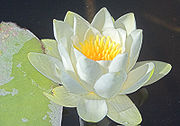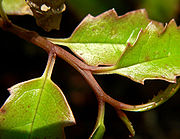
Basal angiosperms
Encyclopedia

Flowering plant
The flowering plants , also known as Angiospermae or Magnoliophyta, are the most diverse group of land plants. Angiosperms are seed-producing plants like the gymnosperms and can be distinguished from the gymnosperms by a series of synapomorphies...
s to diverge from the ancestral angiosperm. In particular, the most basal
Basal (phylogenetics)
In phylogenetics, a basal clade is the earliest clade to branch in a larger clade; it appears at the base of a cladogram.A basal group forms an outgroup to the rest of the clade, such as in the following example:...
angiosperms are the so-called ANITA grade which is made up of Amborella
Amborella
Amborella is a genus of rare understory shrubs or small trees endemic to the island of New Caledonia. The genus consists of only a single species, Amborella trichopoda, and is the only member of the family Amborellaceae. Wood of Amborella lacks the vessels characteristic of most flowering plants...
(a single species of shrub from New Caledonia), Nymphaeales
Nymphaeales
Nymphaeales is an order of plants, which consists of water lilies and other aquatic plants.This order is considered to be a basal, or early diverging, group of angiosperms...
(water lilies, together with some other aquatic plants) and Austrobaileyales
Austrobaileyales
Austrobaileyales is the botanical name for an order of flowering plants, consisting of about 100 species of woody plants, perhaps the most famous of which is the spice star anise.- In different classifications :...
(woody aromatic plants including star anise). ANITA stands for the genera Amborella, Nymphaea, Illicium, Trimenia and Austrobaileya.
The basal angiosperms are only a few hundred species, compared with hundreds of thousands of species of eudicots, monocots or magnoliids. They diverged from the ancestral angiosperm before the five groups comprising the mesangiosperms diverged from each other.
Phylogeny

Amborella
Amborella is a genus of rare understory shrubs or small trees endemic to the island of New Caledonia. The genus consists of only a single species, Amborella trichopoda, and is the only member of the family Amborellaceae. Wood of Amborella lacks the vessels characteristic of most flowering plants...
, Nymphaeales
Nymphaeales
Nymphaeales is an order of plants, which consists of water lilies and other aquatic plants.This order is considered to be a basal, or early diverging, group of angiosperms...
and Austrobaileyales
Austrobaileyales
Austrobaileyales is the botanical name for an order of flowering plants, consisting of about 100 species of woody plants, perhaps the most famous of which is the spice star anise.- In different classifications :...
are not yet clear. Although most studies show that Amborella and Nymphaeales are more basal than Austrobaileyales, and all three are more basal than the mesangiosperms, there is significant molecular evidence in favor of two different trees, one in which Amborella is sister to the rest of the angiosperms, and one in which a clade
Clade
A clade is a group consisting of a species and all its descendants. In the terms of biological systematics, a clade is a single "branch" on the "tree of life". The idea that such a "natural group" of organisms should be grouped together and given a taxonomic name is central to biological...
of Amborella and Nymphaeales is in this position:
Older terms

Eudicots
Eudicots and Eudicotyledons are botanical terms introduced by Doyle & Hotton to refer to a monophyletic group of flowering plants that had been called tricolpates or non-Magnoliid dicots by previous authors...
.
The paleodicots correspond to Magnoliidae
Magnoliidae
Magnoliids are a group of about 9,000 species of flowering plants, including magnolias, nutmeg, bay laurel, cinnamon, avocado, black pepper, and many others. They are characterized by trimerous flowers, pollen with one pore, and usually branching-veined leaves.-Classification:Traditionally,...
sensu Cronquist 1981 (minus Ranunculales and Papaverales) and to Magnoliidae
Magnoliidae
Magnoliids are a group of about 9,000 species of flowering plants, including magnolias, nutmeg, bay laurel, cinnamon, avocado, black pepper, and many others. They are characterized by trimerous flowers, pollen with one pore, and usually branching-veined leaves.-Classification:Traditionally,...
sensu Takhtajan 1980 (Spichiger & Savolainen 1997). Some of the paleodicots share apparently plesiomorphic characters with monocots, e.g., scattered vascular bundles, trimerous flowers, and non-tricolpate pollen
Pollen
Pollen is a fine to coarse powder containing the microgametophytes of seed plants, which produce the male gametes . Pollen grains have a hard coat that protects the sperm cells during the process of their movement from the stamens to the pistil of flowering plants or from the male cone to the...
.
The "paleodicots" are not a monophyletic group and the term has not been widely adopted. The APG II system
APG II system
The APG II system of plant classification is the second, now obsolete, version of a modern, mostly molecular-based, system of plant taxonomy that was published in April 2003 by the Angiosperm Phylogeny Group. It was a revision of the first APG system, published in 1998, and was superseded in 2009...
does not recognize a group called "paleodicots" but assigns these early-diverging dicots to several orders and unplaced families: Amborellaceae
Amborellaceae
Amborella is a genus of rare understory shrubs or small trees endemic to the island of New Caledonia. The genus consists of only a single species, Amborella trichopoda, and is the only member of the family Amborellaceae. Wood of Amborella lacks the vessels characteristic of most flowering plants...
, Nymphaeaceae
Nymphaeaceae
Nymphaeaceae is a family of flowering plants. Members of this family are commonly called water lilies and live in freshwater areas in temperate and tropical climates around the world. The family contains eight genera. There are about 70 species of water lilies around the world. The genus...
(including Cabombaceae
Cabombaceae
Cabombaceae is the botanical name of a family of flowering plants. The family has been recognised as distinct by at least some taxonomists and by APG III...
), Austrobaileyales
Austrobaileyales
Austrobaileyales is the botanical name for an order of flowering plants, consisting of about 100 species of woody plants, perhaps the most famous of which is the spice star anise.- In different classifications :...
, Ceratophyllales (not included among the "paleodicots" by Leitch et al. 1998), Chloranthaceae
Chloranthaceae
Chloranthaceae is the botanical name of a family of flowering plants. The family consists of four genera, totalling several dozen species, of herbaceous or woody plants occurring in Southeast Asia, the Pacific, Madagascar, Central & South America, and the West Indies...
, and the magnoliid clade (orders Canellales
Canellales
Canellales is the botanical name for an order of flowering plants, one of the four orders of the magnoliids. It is defined to contain two families: Canellaceae and Winteraceae, which comprise 136 species of fragrant trees and shrubs...
, Piperales
Piperales
Piperales is a botanical name for an order of flowering plants. It necessarily includes the family Piperaceae but otherwise has been treated variously over time...
, Laurales
Laurales
The Laurales are an order of flowering plants. They are magnoliids, related to the Magnoliales.The order includes about 2500-2800 species from 85-90 genera, which comprise seven families of trees and shrubs. Most of the species are tropical and subtropical, though a few genera reach the temperate...
, and Magnoliales
Magnoliales
Magnoliales is an order of flowering plants.-Classification:The Magnoliales includes six families:* Annonaceae...
). Subsequent research has added Hydatellaceae
Hydatellaceae
Hydatellaceae are small, aquatic flowering plants. The family includes the genus Trithuria, which has been recently re-defined to include the genus Hydatella. The family consists of about a dozen species. These tiny , relatively simple, aquatic plants occur in Australasia and India. The simple...
to the paleodicots.
The term paleoherb is another older term for flowering plants which are neither eudicots nor monocots.

